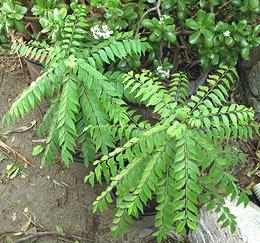 [Kari Leaf; Karuveppilai (Tamil, Malay (Black Neem Leaf)); Kari Patta (Hindi);
R. Murraya koenigii]
[Kari Leaf; Karuveppilai (Tamil, Malay (Black Neem Leaf)); Kari Patta (Hindi);
R. Murraya koenigii]
Essential to the cuisines of Southern India and Sri Lanka this citrus leaf has no real substitute and is not worth much dried. Fortunately it is now grown in Southern California and can be had fresh from most Indian markets, at least around here. They keep only a few of weeks refrigerated. Freeze bagged in water to keep them from drying out. The tree bears pea sized dark purple fruits but I've not heard of them being used for cooking. They have a sweet resinous taste, but not a lot of flesh over the large seed.
In India, curry leaves are used in the cuisines of the south and east but not at all in the north. The southern cuisines are primarily vegetarian, so curry leaves are rarely used with fish, fowl or meat. In Sri Lanka, however, curry leaves are often used in chicken and fish dishes. The leaves also see some culinary use in Malaysia, and throughout the region they are much appreciated for their medicinal properties.
In West Africa, there is great confusion. Two herbs are called "curry leaf", this one and Thai Lemon Basil. Both are used in the region. Sometimes you can tell which is meant by how they are used in the recipe, and some times you can't. If added to a salad or added to a soup when it is nearly done, you can bet on the Basil.
Note that some people do not like the resinous flavor of curry leaves, so it's best to be on the conservative side until you're experienced with them.

Unfortunately they grow slowly. I bought mine at 3 inches
high (that would be about 8 months old). The photo shows them at
about 2 years, and they took 5 years to reach 45 inches, They set
fruit every year, and though I enjoy the sweet, slightly resinous
berry size fruit, setting fruit does stunt their growth
significantly. Seeds are easy to sprout indoors, but mortality
seems quite high, so you need to plant plenty and tend them
carefully.
Another method I've used is to dry roast the leaves in a heavy pan over very gentle heat with plenty of stirring and making sure they don't brown at all. They are very tender so this will take only a couple of minutes. Dried quickly this way they stay quite green and hold their flavor well. In a sealed jar kept in a cool dark place they'll be useful for a couple of months.
The leaves may or may not be removed from the finished dish before serving.
When making curry powders you need to dry roast the leaves as described above, then grind them with the other spices.